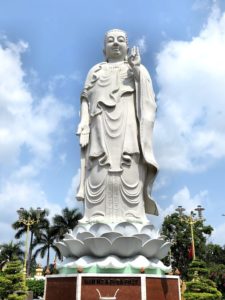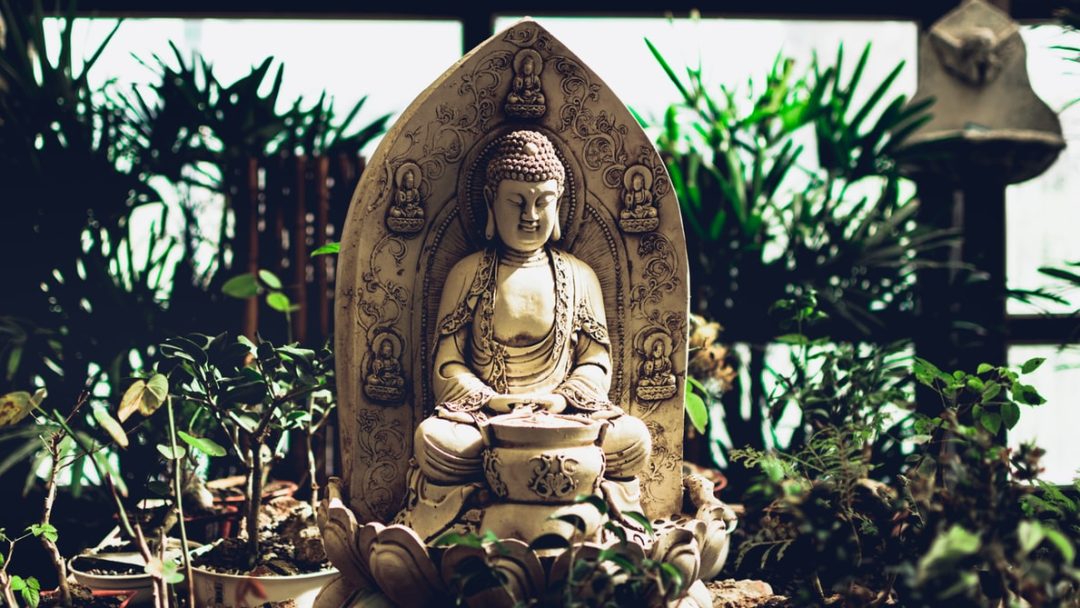Siddhartha Gautama, known Sakyamuni Buddha (“Sakyamuni” translates to “sage of the Sakyas”), is arguably the most important historical figure in the Buddhist tradition and is the one most often referred to when people speak of “the Buddha,” as Buddhists do not believe in one single Buddha.
Siddhartha Gautama Birth
Siddhartha Gautama was born in around 566 BCE in modern-day Nepal as the first child to King Suddhodana of the Sakya nation and Queen Maha Maya, a Koliyan princess. According to traditional tales, on the night Siddhartha has conceived his mother had a vivid dream of a white elephant blessing her, which was understood as a highly auspicious sign. At that time, the custom was for expectant mothers to travel to their family homes to give birth. Queen Maha Maya did set out for her father’s kingdom but unexpectedly went into labor near the town of Lumbini. Assisted by several handmaids, she gave birth to Siddhartha underneath a large tree, and gave him a name meaning “he who has attained his goals.” Soon after the birth, an ascetic soothsayer (or seer) proclaimed the child a future “great king” or “great holy man” and requested for a group of scholars to visit the infant. All agreed with the ascetic’s prediction.
Note that the anniversary of the Sakyamuni Buddha is celebrated, especially in the Theravada tradition, as Vesak.
At the Early Age
Young Siddhartha grew up living a life of luxury as a prince. Especially due to his father’s desire to see him grow to be a great king (one of the two futures predicted for the child), Siddhartha grew up sheltered from suffering and also from religious teachings.
 At sixteen, Siddhartha married Yasodhara as arranged by his father. The couple had one son, Rahula, during Siddhartha’s years as a Prince of Kapilavastu. Over time, however, he grew increasingly skeptical of a life of material wealth and became certain that there was more to life. Going against his father’s rules, he left the palace to explore and meet people outside of approved, in-palace greetings. As he walked, he encountered the elderly, the severely ill, and mourners; these encounters led him to discover, with the help of his friend Chandaka, that all humans grow old, perhaps become ill, and die.
At sixteen, Siddhartha married Yasodhara as arranged by his father. The couple had one son, Rahula, during Siddhartha’s years as a Prince of Kapilavastu. Over time, however, he grew increasingly skeptical of a life of material wealth and became certain that there was more to life. Going against his father’s rules, he left the palace to explore and meet people outside of approved, in-palace greetings. As he walked, he encountered the elderly, the severely ill, and mourners; these encounters led him to discover, with the help of his friend Chandaka, that all humans grow old, perhaps become ill, and die.
Soon after, at the age of twenty-nine, Siddhartha Gautama left his wife and young son, gave away his clothing, and began practicing austerities with a group of five strict ascetics. He continued on this path for six years, during which time the original five grew to admire him as their leader or guide. Siddhartha found the ascetic lifestyle lacking in answers and dangerous, as he himself was near death from starvation. After seeing him accept food from a peasant, the five ascetics left him as he had given up their lifestyle. Siddhartha reasoned that there must be a better way – a “middle way” between excess and austerity – that would bring him to realize the answers to questions about life and its meaning.
Siddhartha sat down beneath the famous bodhi tree in Bodh Gaya, vowing not to rise until he reached enlightenment during a full moon. During this time under the bodhi tree, Siddhartha was visited by Mara, the personification of temptation, who tried to frighten, tempt, and stroke the ego of the soon-to-be Buddha, but failed.
Buddha and The Enlightenment
Once the Buddha attained enlightenment, he experienced a complete awakening and categorized the truths he learned as the Four Noble Truth and the Eightfold Path, the path to attaining enlightenment. His first teaching was given to the five ascetics he had previously lived and practiced with, who upon meeting him again saw that he was enlightened and asked to be taught. The Buddha gave his first teaching, on the importance of following the Middle Way – the path avoiding the extremities of hedonism and asceticism – and gave the Four Noble Truths and the Eightfold Path as instructions. These five ascetics became his first “sangha” or spiritual community.
Siddhartha Gautama, now Sakyamuni Buddha, continued to teach for the rest of his mortal life. He was supported by his ever-growing sangha, generous donations, and a monastery granted to him by King Bimbisara of Magadha for use during inclement weather.
During this time, women were not permitted to enter spiritual communities, but when Yasodhara and an aunt asked to join his sangha, the Buddha welcomed them as the first Buddhist nuns. He preached that status, background, and nationality were not important; all were and are capable of attaining enlightenment.
Siddhartha Gautama died at eighty years of age, forty-five of those spent as the Buddha. He announced, before going into meditation under a tree, that he would be leaving the human world soon. According to many sources, including Dr. C. George Boeree, the Buddha’s last words were: “Impermanent are all created things; strive on with awareness.” (Note that different translations exist.)





